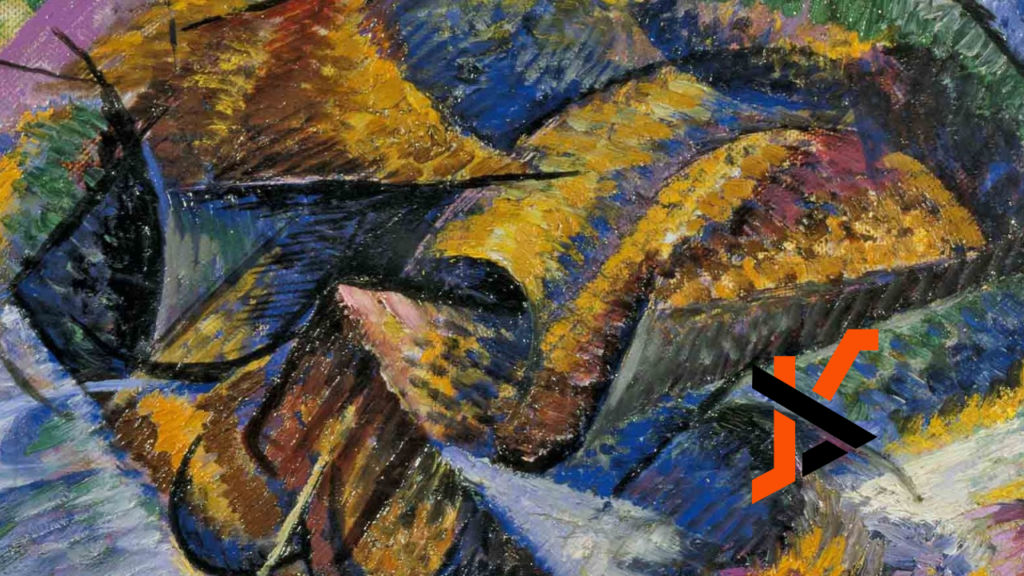Umberto Boccioni’s “Dynamism of a Cyclist“ stands as a monumental testament to the Futurist movement, embodying the essence of speed, technology, and modernity. This piece not only captures the physical motion but also the emotional and psychological vibrancy of the era it represents. In this analysis, we delve deep into the elements that make this artwork a masterpiece, exploring the intricacies of its creation and the profound impact it has had on the art world.
The Genesis of Futurism
Futurism emerged in the early 20th century, primarily in Italy, as a radical rejection of the past and a celebration of speed, machinery, violence, youth, and industry. It was a movement that sought to incorporate the dynamic energy of modern life into art. Umberto Boccioni, one of the movement’s central figures, captured the essence of Futurism through his innovative approach to form and space. In “Dynamism of a Cyclist,” Boccioni transcends traditional representation to evoke the sensation of movement and velocity.
Boccioni’s Artistic Philosophy
Boccioni’s work was heavily influenced by his belief that art should reflect the constant flux of life. He argued for the “universal dynamism” that must be rendered in art, which is evident in how he portrays the cyclist. Rather than depicting a static moment, Boccioni uses lines and shapes to suggest motion, blurring the boundaries between the subject and its environment. This technique reflects his vision of capturing the physical form and the force and energy that propels it forward.
Breaking Down ‘Dynamism of a Cyclist’
Boccioni’s use of vibrant colors, intersecting planes, and fragmented forms in “Dynamism of a Cyclist” creates a sense of rhythm and movement. The painting’s composition directs the viewer’s eye to follow the swirling contours, simulating the speed experience. By breaking down the figure of the cyclist and the bicycle into overlapping shapes, Boccioni conveys the fluidity and dynamism inherent in motion, challenging the viewer’s perception of reality.
Symbolic Interpretations
The artwork is not merely a depiction of a cyclist in motion; it symbolizes the modern man, intertwined with machinery, moving forward into the future. Boccioni’s choice to focus on a cyclist rather than a more technologically advanced machine, like an automobile or airplane, emphasizes the human element within the technological advance. This choice reflects the Futurist fascination with the human body’s potential to merge with the machine, creating a new form of beauty that resonates with the speed and energy of contemporary life.
Boccioni’s Impact on the Art World
“Dynamism of a Cyclist” not only exemplifies the core principles of Futurism but also marks a significant moment in the evolution of modern art. Boccioni’s innovative techniques and philosophical approach have influenced countless artists and movements, from abstract expressionism to digital art forms that seek to capture the essence of motion and transformation.
Legacy and Preservation
Today, Boccioni’s work continues to be celebrated for its visionary approach and ability to capture the zeitgeist of the early 20th century. Preserving his masterpieces, such as “Dynamism of a Cyclist,” allows future generations to witness the groundbreaking shift in art that Boccioni and his contemporaries initiated. This piece remains a pivotal work in understanding the trajectory of modern art and its ongoing dialogue with technology and movement.
In exploring the depths of “Dynamism of a Cyclist,” we are reminded of the power of art to reflect and shape our understanding of the world. Boccioni’s masterpiece, a pivotal work within the art world, continues to inspire and challenge, embodying the perpetual motion of life itself. For those interested in exploring more about Boccioni’s work and the Futurist movement, “Dynamism of a Cyclist” by Umberto Boccioni serves as a profound starting point, offering insight into the fusion of art, technology, and human emotion.
Through this analysis, it becomes evident that Boccioni’s “Dynamism of a Cyclist” is not just a painting; it is a manifesto of Futurism, a declaration of the modern spirit, and a timeless exploration of movement and change.

